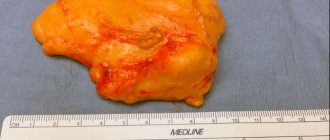Surgical removal of a lipoma is a classic in the genre of neutralizing formations that are localized in fatty tissue. Despite the fact that the technique is the oldest used in medicine, it is actively in demand even today.
This commitment is explained by the fact that surgical removal is an effective method, which is confirmed not only by official medicine, but also by numerous patients. All of them were satisfied with the results obtained, especially considering that the price of the intervention remains affordable compared to alternative technologies.
Services and prices
Removal of lipoma more than 3 cm
7000 ₽
Sign up
Removal of lipoma up to 3 cm
4000 ₽
Sign up
Lipoma is the most common soft tissue tumor and consists of fat cells surrounded by a thin fibrous capsule. Popularly, such a neoplasm is called a wen.
Often, a person who is attentive to his body may stumble upon such a subcutaneous formation. Such a finding can cause, at a minimum, caution, and sometimes fear of the oncological process. The unknown is always scary. If you have any concerns, you should consult your doctor. In most cases, subcutaneous neoplasms in soft tissues are benign and do not pose a threat to the owner of the wen. However, lipomas still require the supervision of a specialist who must recognize a malignant process, if one occurs.
Peculiar red flags, signs that make you wary, are rapid tumor growth, pain, and the presence of two or more similar formations on the body.
By external signs, lipoma is little distinguishable from liposarcoma, hygroma, subcutaneous cyst, hematoma, parasitic invasion, inflammation or consequences of injury. Therefore, it is important that any neoplasms be examined by a doctor.
First of all, the question of the malignancy of the tumor is decided at the appointment. Liposarcoma occurs more often in middle-aged and elderly people. This is an aggressive and fast-growing tumor that can put pressure on surrounding organs and tissues and cause pain. Situations when an existing lipoma degenerates into a malignant tumor rarely occur. However, the oncological process requires a radically different approach to diagnosis and treatment, so it is important to diagnose it as early as possible.
Lipomas may have a hereditary predisposition. This fact, combined with the spread of wen to other parts of the body, makes the doctor suspect lipomatosis. Lipomatosis accompanies a number of hereditary syndromes such as Madelung's disease and Dercum's syndrome. Diseases with a family history require a special approach to therapy.
Lipomatosis
When there are many lipomas (up to 100 or more), the disease is called lipomatosis.
Varieties:
- multiple, familial or Rocha-Lori
- multiple symmetrical or Madelunga
- painful or Dercuma
Reasons for appearance
There are many factors that influence the formation of lipomas. Among the reasons are hereditary predisposition, impaired metabolism of fatty acids in the body, liver disease, pancreatic disease, non-compliance or violation of hygiene rules.
For a long time it was believed that soft tissue injury predisposes to the development of lipomas, but this fact was subsequently refuted in research. Thus, doctors agree that one reason that would explain all the processes has not yet been found. However, predisposition to gastrointestinal lipomas has a proven connection with a gene mutation on chromosome 12. In other cases, the reasons remain unknown.
Why do lipomas occur?
To date, scientists have not been able to come to a consensus on why lipomas develop and why multiple lipomas are more common rather than single formations. Lipomatosis has nothing to do with the patient’s weight category or the amount of subcutaneous fat in his body, since formations can appear even in very slender people.
According to researchers, the appearance of wen is associated with a genetic predisposition. It can also be triggered by metabolic disorders in the body, hormonal imbalance, or thyroid disease. Some scientists are convinced that wen occurs due to malfunctions of the gallbladder and liver, as well as due to slagging in the body.
Symptoms and classification
Lipomas are distinguished by anatomical location into lipomas of the head, face and neck, lipomas of the trunk, extremities, chest (mediastinum), mammary gland, gastrointestinal tract, internal organs, retroperitoneal tissue, spermatic cord. There are also rare localizations in the myocardium, lungs, and meninges.
Another classification of adipose tissue tumors involves a clinical division:
- Lipoma surrounding nerve structures is called perineural . Due to compression of the nerves it can cause severe pain. Removal of perineural lipomas differs from subcutaneous lipomas and requires a highly qualified surgeon;
- A tumor growing in the spinal canal (usually in the lumbar region) is called lumbosacral lipoma; Mostly occurs in children and is combined with underdevelopment of spinal structures;
- Lipoma of the joint and its structures (synovium, vagina, tendons);
- Intermuscular lipomas are formed from areas of adipose tissue between muscle fibers;
- Angiomyolipoma is a tumor of fatty and muscle tissue, which in most cases grows in the kidneys and pancreas. Middle-aged and mature men are more predisposed to its formation;
- Subcutaneous lipoma is a formation of varying sizes in the subcutaneous fat tissue. In everyday life it is usually called wen.
Lipomas usually occur alone. However, some patients discover several tumors at once. Such cases are most often associated with hereditary diseases and require careful study by specialists. The most common places for lipomas to form are the neck, back and limbs.
A subcutaneous lipoma is a mobile, elastic seal in the form of a lump or ball, which does not cause pain when pressed. A neoplasm can cause pain if it grows beyond its capsule into healthy tissue or due to compression of adjacent nerves.
For example, a wen located on the head can cause headaches, and the same formation on the neck can cause hoarseness and difficulty swallowing.
Gastrointestinal lipomas differ from their subcutaneous counterparts. Small formations in the intestine do not cause symptoms and are often discovered incidentally during an instrumental examination of the gastrointestinal tract. However, if it increases in size, this happens when the tumor reaches 2 or more centimeters in diameter, the lipoma can block part of the intestinal lumen and cause intestinal obstruction, intussusception, stool problems, abdominal pain and even bleeding.
Symptoms of the disease
Unlike most other tumors, lipoma grows and develops quite slowly, causing virtually no inconvenience to the carrier. Patients seek its removal mainly for two reasons:
- The lipoma appears on an open area of skin and does not look aesthetically pleasing.
- The tumor has formed in the immediate vicinity of the nerve endings and, as it grows, begins to put pressure on them.
It is also not uncommon for the skin over the lipoma to become damaged and the wound to become infected. When inflammatory processes are added to the tumor, the patient may note:
- Decreased mobility and functionality of the affected area.
- Minor pain.
- Increased body temperature.
- Redness of the skin.
- Inflammation in the area where the skin has been damaged.
- Local (depending on the location of the tumor) manifestations: wheezing and difficulty swallowing - in the neck, arrhythmia - if the heart is affected, dizziness and migraine if the lipoma is located near the vessels of the head.
In this case, pathology can already cause problems, and considerable ones. You should consult a doctor as soon as you discover that:
- The tumor became denser and its growth rate noticeably accelerated.
- The lipoma appeared on the face or on any other open, and therefore least protected, area of the skin.
- The tumor has formed in a high-friction zone, where it can easily be damaged.
- The lump turned red, began to cause discomfort, began to bleed and/or discharge pus.
Treatment methods
The treatment method is selected based on the location of the tumor, size and medical history of the patient. First of all, the doctor must make sure that the patient’s neoplasm is benign. To do this, the doctor carefully examines the patient, collects anamnesis and, if necessary, refers him to the necessary tests. For the differential diagnosis of lipomas, ultrasound examination of soft tissues, computed tomography, magnetic resonance imaging are used and, if a malignant tumor is suspected, a tumor biopsy is taken.
The most common type of tumor from adipose tissue is a subcutaneous lipoma, which does not cause dysfunction of organs, systems and does not threaten the patient’s life, and removal is performed only for cosmetic purposes.
Also, indications for surgical treatment of lipoma are large tumor sizes, 5 cm or more, and the presence of symptoms caused by the tumor.
There is no effective conservative treatment for lipomas. It is also worth noting that traditional methods such as heating and applying ice do not affect tumors from adipose tissue. However, they can cause serious complications if the neoplasm is of a different nature. For example, when atheroma is heated (atheroma is an accumulation of sebaceous secretion that clogs the duct of the sebaceous gland and causes inflammation), inflammation may spread and infect healthy tissues that are nearby.
Among the surgical methods for treating lipomas are:
- lipoma excision
- liposuction
- laser removal
- endoscopic method (for gastrointestinal lipomas)
Prevention
To exclude the possibility of the appearance of benign fatty tumors, at a minimum, maintaining a healthy lifestyle is required. It is necessary to exclude bad habits and factors that can provoke changes in adipose tissue (stress, increased blood sugar). During hormone therapy or if you suspect a hormonal imbalance, you need to monitor your hormonal levels under the supervision of an endocrinologist. It is very important to periodically carefully examine and palpate the skin to prevent the appearance of neoplasms. To do this, you can involve relatives and close people. If you identify nodes, compactions, infiltrates, lumps or other formations, consult a surgeon. Don't delay.
Advantages and disadvantages of various methods
- Lipoma excision.
Excision of a lipoma is the simplest and most affordable way to remove a wen. The operation is performed under local anesthesia. The surgeon injects the lipoma with an anesthetic and removes the tumor along with the capsule through an incision in the skin. Removal of the fibrous capsule is an undeniable advantage of this method. This prevents the re-formation of lipoma in the old place, which means it reduces the risk of relapse to a minimum. This method also allows one to examine the histological structure of the tumor. In general, the operation lasts no more than half an hour.
- Liposuction.
Liposuction allows the tumor to be removed through a small hole. A special device is inserted into the cavity of the wen, which destroys the lipoma. Many doctors and patients love this method for its minimal invasiveness and good cosmetic results. However, the disadvantage is the inability to remove the fibrous capsule of the wen, which creates the possibility of future relapse of the tumor.
- Laser removal.
Laser techniques are used to eliminate tumors larger than 3 cm. The method is gentle, carries minimal risks of bleeding and infection, and does not leave wounds or scars.
Reviews:
Alexander
I have hereditary lipomatosis. My father also has the same problem. About 5 years ago, lipomas appeared and began to increase in size on the arms, legs and abdomen. At first I tried not to pay attention to them, but others notice them. He began to hide them. I had to wear only long sleeves and only trousers, even in the summer, and this is really annoying. But most importantly, new formations appeared. They hurt when pressed. On my back they even began to interfere with my sleep. Sheer discomfort. I turned to Alexander Shadzhievich, he explained everything and at the same time removed 11 wen in one visit using the radio wave method. I liked that there was no pain during removal, only minor discomfort at the beginning of anesthesia. The syringe and needle were small. The operation went almost unnoticed. After the operation there was no pain either. I did the dressing myself. Very simple. The doctor recommended comfortable small bandages that do not come off. I was very afraid that the scars after the operation would be large, but I managed to remove lipomas from small incisions. Small scars remain. The entire operation took about 1.5 hours. Previously, I applied to other places, but they offered to remove 2-3 formations at a time and the price was higher. The clinic at the place of residence refused to remove it at all. It is very convenient that many formations were removed at once, most of them. The main thing is that the largest ones were removed. It became easier. There are a few very small, unnoticeable lipomas left; if they grow, I’ll remove them later too. Thank you doctor for your attentive attitude, I am very pleased.
Valery
Maksim
Anton
Maksim
Preparation for the procedure
In case of subcutaneous lipoma removal, no special preparation is required. The mini-surgery is performed on an outpatient basis, meaning it does not require hospitalization. The surgeon performs all necessary manipulations under local anesthesia. Thus, the procedure is painless for the patient.
Giant subcutaneous lipomas, as well as neoplasms of the intestines, internal organs, and peritoneum require more serious and thorough preparation. Operations of this type are carried out with hospitalization of the patient. Before the intervention, samples are taken and, if necessary, additional studies are done. Operations performed under general anesthesia require restriction of water and food on the eve of the operation.










